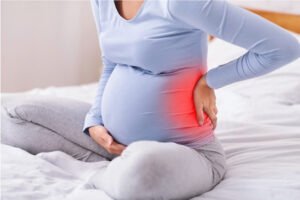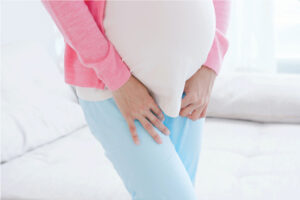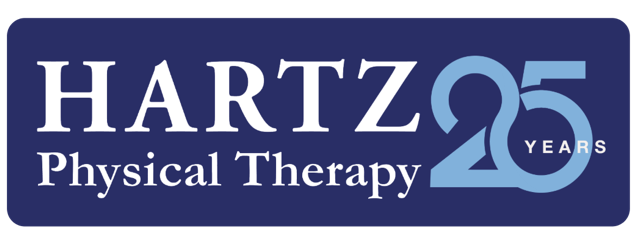Written by Jennifer Graham, DPT, GCS
Article
Exercise, Health & Wellness, Physical Therapy, Pregnancy

Is it safe to exercise when your pregnant? Yes! Exercise is safe during pregnancy so if you have been active in the months leading up to your pregnancy, it is safe to continue unless you are told not to by your physician. Exercise including cardio does NOT increase the risk for miscarriage in a normal, low risk pregnancy.
Consider the following exercises during your pregnancy:
- Walking: fresh air, sunshine walking with friends is all good for the soul and a great workout that is easy on your joints and muscles.
- Riding a stationary bike: safer than a regular bike even as your stomach grows because it is less likely you will fall off, and there is nothing to avoid such as rocks, and traffic.
- Swimming: the buoyancy of the water helps support the weight of the baby, it’s relaxing and easy on your joints and muscles and is especially good if you have low back pain doing other activities.
- Strength Training: will help you build muscles, and it is safe to use weights if they are not too heavy.
- YOGA or Pilates: Yoga is a great low-impact workout for your pregnancy, can lower your blood pressure and stress it also helps you stretch your muscles. Pilates can help develop your pelvic floor muscles to help with delivery and is another great way to stretch. Advise your instructors that you are pregnant so that they can modify positions as you progress through pregnancy.
- Low-impact aerobics classes – with low-impact aerobics, you always have one foot on the ground or equipment. Walking, riding a stationary bike and using an elliptical machine are great examples of low-impact aerobics. These types of exercise do not put as much strain on your body as high-impact aerobics like running do.
If you were not active prior to pregnancy, consider a prenatal yoga class to help gently ease into activity in a safe way.
Exercise benefits everyone, but during pregnancy the benefits are many and include:
- Promotes healthy weight gain for mother and baby
- Reduces the risk of babies measuring too large for their gestational age.
- Lowers the risk of gestational diabetes and pre-eclampsia
- Has been shown to help reduce duration of labor, increase chance of vaginal delivery, and decrease the risk of tearing during delivery.
- Prepares the body for delivery by strengthening and relaxing your pelvic floor.
- Helps improve psychological well-being, improves sleep, and decreases hip and low back pain during pregnancy.
The guidelines for pregnancy are the same as those of the general population… 150 minutes per week. A good rule of thumb is 30 minutes, 5 days a week of light to moderate exercise. It is best to split time up throughout the week to avoid overexerting yourself. Listen to your body. It is good at giving you signals that you should stop exercise or slow down. Avoid exercising to the point of breathlessness or exhaustion as this may be a sign that you and your baby are not getting the oxygen you need. You should also watch out for signs such as cramping, pelvic heaviness, vaginal bleeding, or increased discharge. Avoid exercising on uneven terrain as you have increased mobility in your joints during this time and this may put you at an increased risk for fall or injury. Avoid any contact sports or activities with increased jarring or sudden movements such as horseback riding. Give yourself plenty of rest breaks and drink plenty of fluids while you exercise. During your 2nd and 3rd trimesters avoid lying on your back during exercise (and sleep) as this can place increased pressure on major blood vessels and decrease blood flow for you and to the uterus.
 If you start to feel increased hip or low back pain during your pregnancy due to the postural changes of your body, weight gain, and changes in balance and gait (all of which are normal) a pelvic health PT can help to reduce pain by teaching you strategies to help compensate during this time of increased stress on your body. A pelvic floor physical therapist has received extra training regarding the muscles of the pelvic floor and their direct relationship with pregnancy and delivery. They will do a full body assessment to help with back pain, posture, core, pelvic floor, and LE strength to help your body better support you and your baby during pregnancy.
If you start to feel increased hip or low back pain during your pregnancy due to the postural changes of your body, weight gain, and changes in balance and gait (all of which are normal) a pelvic health PT can help to reduce pain by teaching you strategies to help compensate during this time of increased stress on your body. A pelvic floor physical therapist has received extra training regarding the muscles of the pelvic floor and their direct relationship with pregnancy and delivery. They will do a full body assessment to help with back pain, posture, core, pelvic floor, and LE strength to help your body better support you and your baby during pregnancy.
 Another common complaint from women is incontinence or leaking during pregnancy or after childbirth when they sneeze, cough, laugh, or lift something. They may also experience increased urinary urgency “gotta go” symptoms as well as constipation during and after pregnancy. Just because this is common, does not mean it’s normal! A pelvic health PT can do a full assessment of your pelvic floor, including an internal exam if warranted and cleared by your provider to check muscle strength, endurance, and coordination as well as give you tips and exercises to help with all these symptoms.
Another common complaint from women is incontinence or leaking during pregnancy or after childbirth when they sneeze, cough, laugh, or lift something. They may also experience increased urinary urgency “gotta go” symptoms as well as constipation during and after pregnancy. Just because this is common, does not mean it’s normal! A pelvic health PT can do a full assessment of your pelvic floor, including an internal exam if warranted and cleared by your provider to check muscle strength, endurance, and coordination as well as give you tips and exercises to help with all these symptoms.
Pregnancy is a marathon event for your body and can cause long lasting changing following the delivery of your baby. Many times, women develop low back, pelvic, and hip pain due to the normal changes that take place over those 9 months that do not resolve post-partum. If you continue to have pain or incontinence following the delivery of your baby, a physical therapist will help to evaluate these issues and help you get back your function and quality of life. If you have questions please reach out to me at jgraham@hartzpt.com.
